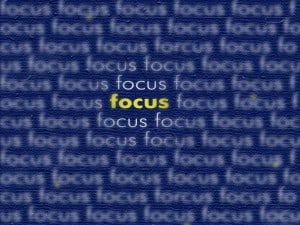Focus is held in high esteem in our culture and in business. We medicate, caffeinate, and meditate to summon it. It’s celebrated on billboards and taught through thousands of books and workshops. Those who possess the holy grail of focus are considered successes and become role models to others.  Those who don’t just need to work a little harder. Right?
Those who don’t just need to work a little harder. Right?
Maybe not.
Each of us has a unique relationship with focus. What’s yours?
Your FQ (Focus Quotient)
Take this quick, confidential self survey.
| As a child, were you rewarded for finishing tasks? | Yes | No |
| Do you require quiet to get things done? | Yes | No |
| Can you sit and concentrate on one thing for long periods of time? | Yes | No |
| Do you frequently block out the world around you when you’re focusing on something? | Yes | No |
| Would others describe you as one who can ‘hunker down and crank things out’? | Yes | No |
While each of these survey items alone could be considered a virtue, taken together they may suggest a significant challenge to your personal health and professional effectiveness. (Too much of a good thing isn’t always a good thing.)
I’ve come to the counter-intuitive conclusion that this type of traditional focus actually impedes progress and results. I’ve seen it time and again in the leaders with whom I work… and I’ve experienced it personally throughout my career. Focus – the top strategy for achieving purpose, goals, and success – may be the most misconstrued of human capacities.
The Two Faces of Focus
Throughout our upbringing, school, and work experiences, most of us have learned and honed the potentially destructive form of focus: forced and fierce. You know you’ve mastered this face of focus when you ‘make yourself’ sit down and crank something out, when you shoo others away so you can concentrate and finish a task, when ‘discipline’ becomes your middle name. Does it ever feel like a death march to your goals? It’s likely the fierce, forced side of focus you’re feeling.
But let’s look at definitions for a moment and explore the physics here. ‘Focus’ is where rays of light converge. Rays of light aren’t hard, firm or heavy. They’re light. They’re energy. They’re dancing.
- Is it possible that there’s another face of focus?
- Could focus be more effective when it’s softer?
- Might there be value in finding ways to ease into focus rather than force it?
My life has been (and continues to be) a quest for the fluid, flexible face of focus. The place where my attention is not so concentrated that it blocks everything out but rather where it’s soft and allows my peripheral vision to pick up on images and input around the edges that might actually enrich my process, outcomes, and life. The place where there’s freedom to tap into my heart as well as my head. The place where joy, fun, and lightness can clear the way for rigor and results. And the place where burn-out is replaced with an approach that’s sustainable over the hopefully long-haul of my life.
In next week’s Part 2 post, I’ll share a few strategies that I’ve discovered that are helping me cultivate this more fluid, flexible and fun face of focus.
But for now, what does focus feel like to you? Is it a death march or dance?

